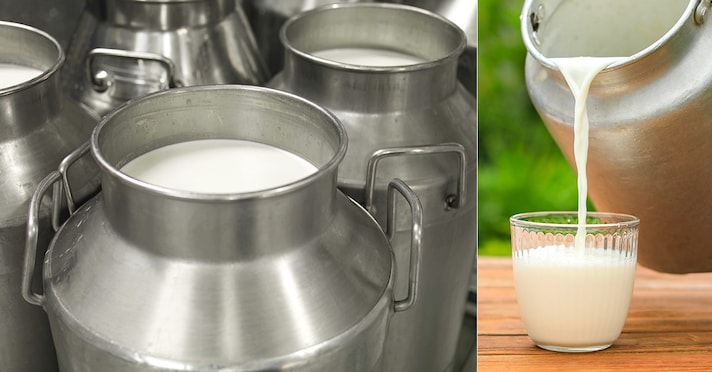
Milk is the first food we taste as a newborn and one that stays with us for the rest of our lives. Complete and nutritious, delicious as a breakfast drink or as an ingredient in all kinds of sweet and savory recipes, milk is a simple yet complex food, nutritious and very beneficial for the body.
Cow's milk from dairy animals (cow's milk is generally the most common) is the most popular type, although "plant-based" milks are increasingly available on the market today, a valid alternative for those who are lactose intolerant or follow a vegetarian diet. If you love cow's milk, however, it can be difficult to choose which type to buy: there are so many different types on grocery store shelves. What are the differences between the various types of milk on the market, and how can you choose the best one? We'll explain in this guide.
Types of Milk Available
Not all milk is the same, or rather, the type of processing it undergoes isn't the same. The wording you find on the label isn't random: each one refers to a particular way the milk is treated before being put on sale and therefore indicates a milk with specific characteristics, ranging from fat content to shelf life, to storage method. Let's look at the types of milk you can find on the market.
Raw Milk
Raw milk is the purest milk you can drink, the one that remains natural longer than all others: it is usually freshly milked and has not undergone any heat treatment, a characteristic that makes it highly nutritious and particularly flavorful. For the same reason, it is a milk that should be consumed within a few days and always after boiling; precisely for this reason, its shelf life is very short and it is not sold in large retailers, but is generally found only at farms.
Fresh Milk
Fresh milk is one of the most common types found in grocery stores. In this case, the term "fresh" refers to a product that has undergone a brief pasteurization process within the first 48 hours of milking. The heat treatment it undergoes is very rapid (about 15 seconds at 161°F/72°C), which is why it is the type of milk that most closely resembles freshly milked raw milk. Thanks to the brief pasteurization process, it best preserves its flavor and nutritional qualities, but it does not have a long shelf life: if kept in the refrigerator, it will keep for a maximum of six days.

Microfiltered Milk
A less common variation of fresh milk is microfiltered milk. This means that, before being pasteurized, this milk is filtered through a fine-mesh strainer to remove some of the more perishable components and some of the fats naturally present in fresh milk. It retains the flavor of fresh milk but, thanks to this additional process, lasts longer in the refrigerator and can be kept for up to 10-15 days.
UHT (Ultra High Temperature) Milk
UHT milk, which stands for ultra high temperature, is the milk you commonly call "long-life" milk, the kind you find on shelves outside the refrigerated section. This milk undergoes a sterilization process for 2-5 seconds at temperatures between 275-285°F (135°-140°C): this means that all bacterial growth is eliminated, and once the milk is placed in the classic Tetra Pack container, it can be stored for up to six months if unopened; if opened, however, it should be consumed within a couple of days.
Highly Digestible Milk (HD)
Lactose intolerance is an increasingly common problem, which is why commercially available milk includes highly digestible (HD) milk. In this case, cow's milk is processed to minimize the amount of lactose, making it more digestible. Please note: "lactose-free" doesn't mean it's completely lactose-free, but rather that it's present in a low or negligible amount (equal to 0.1% per 100 ml of milk). This is essential to know, for example, if you have a true allergy or a very severe intolerance. Highly digestible milk is available both fresh and shelf-stable.
Enriched Functional Milk
Recently, enriched functional milk has been added to the range. This milk is enriched with a series of substances it doesn't naturally contain (phytosterols, fiber, etc.) or in which the nutrients it already contains are enhanced (calcium, vitamins, proteins, etc.). This milk is usually consumed by those with specific needs, such as particular nutritional deficiencies, or is recommended for very young children during their growth phase.
Nutritional Breakdown of Milk Types
There's another differentiation you can find in milk, a classification related to a more strictly nutritional point of view. Specifically, it's a categorization that depends on the level of skimming, or the physical process of separating water from fat: the more skimmed it is, the less fat it contains. A lower fat content, clearly, also translates into a lower energy and nutritional intake.
All the types of milk listed above can therefore be further divided into:
- whole milk, that is, milk that contains at least 3.6 grams of fat and approximately 64 calories per 100 grams of product;
- semi-skimmed milk, i.e. milk with a fat content ranging between 1.5 and 1.8 grams for a caloric intake of approximately 40 kcal;
- skimmed milk, that is, milk that contains approximately 0.3 grams of fat and no more than 34 calories per 100 grams of product;
- Lactose-free milk, meaning milk with a significantly reduced lactose content—generally less than 0.1%—the main sugar found in many dairy products (which is why it tastes sweeter than regular milk). The nutritional values vary depending on whether it's whole, semi-skimmed, or skimmed. Whole milk contains around 3.5 grams of fat and 60 to 65 calories; skimmed milk, on the other hand, contains between 0.1 and 0.3 grams of fat and 33 to 37 calories per 100 grams.

Which Milk Should You Choose?
There's no universally best milk: it depends on your storage needs, your taste preferences, and your health, which may lead you to prefer a lower-fat or lower-lactose milk. Having said this, we can add that nutritionists, for an adult in generally good health, should prefer one particular type: fresh, semi-skimmed milk.
According to experts, fresh milk is actually more beneficial for health because, being the closest thing to raw milk, despite processing, it retains a high level of the nutritional properties that make this drink so beneficial, particularly the vitamins and proteins that contribute to strengthening bones and the cardiovascular system. Why semi-skimmed? It contains just the right amount of fat, neither too little nor too much, and despite the reduced fat content, it retains the same amount of protein and minerals, as well as the same flavor. Lower fat means the milk is lower in calories, more easily digestible, and has almost zero cholesterol.
;Resize,width=767;)
